
Wine Culture and Information since 2002 - Volume 22
 Wine Culture and Information since 2002 - Volume 22 |
|
Contrasts of Lambrusco di Sorbara and Vernaccia NeraSparkling wines made with red berried grapes clearly represent the minority in bubble's scene, however even red sparkling wines are capable of giving pleasing surprises |
|
Sparkling wines represent a particular category among all styles of wine and are an enological practice not always easy to perform. Adding bubbles to a wine is a virtually simple operation – a result that can be obtained even with the easy and coarse carbonation – but creating elegance and balance is a true art requiring a higher technical and technological expertise than in any other style of wine. As for the “fascinating bubbles”, it must also be said there are different methods used to create them in a wine and each of them gives results of distinct finesse and quality. Leaving aside the coarse carbonation – which is actually used for certain semi-sparkling wines – the main methods adopted for the production of quality sparkling wines are Martinotti method or Charmat method, and the so called classic method which requires the refermentation and aging of the wine in a bottle for many months and, in some cases, for several years. In the family of sparkling wines, those produced with red grapes definitely represent the minority. The reason is often due to the typical organoleptic qualities of red grapes, in particular the presence of polyphenolic substances. The so called tannins, in fact, would make sparkling wines decidedly unbalanced because the combined action of carbon dioxide and acidity would exalt this characteristic and make the wine unpleasant. For this reason, and in general terms, when red grapes are used for the production of sparkling wines, it is preferable to vinify them “in white”, that is by separating the skins immediately after crushing. This does not mean, of course, it is not possible to make sparkling wines with a red wine, however, it is essential to carefully choose both the grapes and their vinification. Lambrusco is certainly the most significant case of the production of red sparkling wines, not the only one, of course, and in this month's tasting by contrast we compare it to another variety typically used for wines with bubbles: Vernaccia Nera.
|
|
Lambrusco di Sorbara, from which the homonymous and famous Denominazione d'Origine Controllata area in the province of Modena takes its name, is probably the most famous variety belonging to the so called lambruschi family. It should be said, in fact, that, in this sense, Lambrusco di Sorbara is only one of the many members of this family, which enological use is mainly destined for the production of sparkling wines, both dry and slightly sweet. Lambrusco di Sorbara bears a flower which is considered hermaphrodite even if physiologically “feminine”. This characteristic therefore requires the presence of a variety capable of playing the role of pollinator in order to allow the vine to generate the berries. For this reason, in the vineyards of Lambrusco di Sorbara are usually found vines of Lambrusco Salamino which play this important role, a condition that also determines the composition of the wines in the territory of Sorbara. Lambrusco di Sorbara DOC, in fact, provides for a minimum 60% of this variety and the remaining part of Lambrusco Salamino. The grapes belonging to the family of lambruschi have been known since immemorial times. Generically classified in the past as vitis labrusca, many authors of the past have written about both the grapes and the wines they produce, including Pliny the Elder, Varro and Cato. In particular, as for Lambrusco of Sorbara, there are mentions dated back to the 1800s, confirming, this grape was already cultivated and common in the territories of Modena and Reggio Emilia, areas in which this variety is still common today. The typical wine making destination of this grape is basically reserved to the production of semi-sparkling and sparkling wines, the latter produced both with the technique of fermentation in closed tank – that is, the Martinotti or Charmat method – including excellent examples of refermentation in bottle, especially in recent times. This technique gives Lambrusco di Sorbara a wine making interpretation of interesting quality, opposing to the usual and modern closed tank production giving dry and sweet styles.
|
||||
|
Vernaccia Nera grape has always been associated to the viticulture of the Marche region and, in particular, to Vernaccia di Serrapetrona, in the province of Macerata, an area recognized as Denominazione d'Origine Contrallata e Garantita, mainly famous for the sparkling wines produced with this grape. In addition to Marche, Vernaccia Nera is found – although in quite marginal quantities – in some eastern areas of Umbria, in particular Cannara and with which is produced the homonymous Vernaccia and locally known as Cornetta. The most significant and famous wines from Vernaccia Nera are clearly and undoubtedly produced in the Marche region in Serrapetrona as sparkling – the most famous and recognized one – and table wine styles. The name Vernaccia, exactly like the other grapes having this term in their names, probably derives from the Latin vernaculum, meaning something “of the place”. This theory seems to be confirmed by what Columella wrote in his De Re Rustica, referring to these grapes as vitis vernacula, that is “the home grape” meaning “of the place”. Vernaccia di Serrapetrona certainly is the most famous wine produced with Vernaccia Nera grape. This wine of the Marche region is produced in a rather small territory – in the municipality of Serrapetrona and partly in those of Belforte del Chienti and San Severino Marche, in province of Macerata – with a very particular technique and in very limited quantities. It should be noted the production of this wine is the result of three distinct fermentations and it is obtained from “two wines”: one produced with freshly harvested grapes, the other one with dried grapes. The must obtained from dried grapes is then fermented together with the first wine and, at the end of this phase, the production continues with another fermentation, usually in a closed tank, finally obtaining a sparkling wine. Vernaccia di Serrapetrona is produced as dry and sweet styles, allowing a very interesting versatility in the pairing with food.
|
The wines we will choose for our tasting by contrast are produced with the two varieties of this month: Lambrusco di Sorbara and Vernaccia Nera, in both cases as sparkling style. As for the first grape, we will choose a Lambrusco di Sorbara Secco, that is dry, produced with the fermentation in a closed tank, that is with the Martinotti method. The wine representing Vernaccia Nera is Vernaccia di Serrapetrona Spumante, also in this case in the dry style and produced with the fermentation in closed tank. For both wines we will pay attention to the composition of the grapes as the respective production disciplinary allow the use of other varieties, therefore we will make sure the two wines are produced with the respective grapes only. Both wines of this month's tasting by contrast belong to the latest vintage and are served in their respective tasting glasses at a temperature of 16 °C. (61 °F) We can start our tasting by contrast from the evaluation of the appearance of the two wines, starting from Lambrusco di Sorbara. From the above, let's observe the wine in order to appreciate foam and the evolution of bubbles: the size is of medium size, the foam has good persistence and forms a crown in a relatively short time. Let's tilt the glass over a white surface and observe the color: we can clearly see a pale ruby red with an evident purple hue, of moderate transparency. Let's now evaluate the nuance by observing the wine towards the opening of the glass: we see a cherry pink color, also in this case, with hints of purple. Let's move on to the evaluation of Vernaccia di Serrapetrona, starting from the analysis of the foam: also in this case the evolution is abundant and tends to dissolve quickly leaving an evident crown. Also in this case, bubble's grain is of medium size. The color is dark ruby red with a low transparency, decidedly opposed to the appearance of Lambrusco di Sorbara. The nuance of the color confirms the ruby red with evident purple tones. Lambrusco di Sorbara and Vernaccia Nera make wines with very different olfactory profiles, in both cases with clear and intense hints of fruit sensations. Lambrusco di Sorbara is more oriented towards aromas reminiscent of fruit with a red skin and pulp, whereas Vernaccia Nera mainly associates its olfactory profile to fruit with black skin and pulp. In both wines there are aromas recalling the world of flowers. In Lambrusco di Sorbara are generally perceived aromas of cherry, raspberry, strawberry and plum, often followed by peach and apple. As for the aromas associated to flowers, in Lambrusco di Sorbara can be recognized cyclamen, rose and violet. The profile of Vernaccia Nera substantially differs from that of the Emilian grape. In wines produced with the variety from Marche are in fact perceived aromas of blackberry, plum, black cherry, blueberry, frequently followed by raspberry and strawberry. As for aromas of flowers, in Vernaccia Nera the most common one is violet. Let's proceed with the evaluation of the olfactory profiles of the wines of our tasting by contrast, starting from Lambrusco di Sorbara. By holding the glass in vertical position and without swirling, proceed with the first smell in order to appreciate the opening of the wine, that is the initial aromas which can be perceived from the glass. Lambrusco di Sorbara opens with aromas of cherry, strawberry and raspberry, with a pleasant sensation of freshness. Let's now swirl the glass in order to favor the oxygenation of the wine – including the release of carbon dioxide – operation allowing the development of other aromas. The olfactory profile of Lambrusco di Sorbara is completed by aromas of blueberry, plum and peach, as well as by floral aromas of cyclamen, rose and violet. Let's now move on to the evaluation of the olfactory profile of Vernaccia di Serrapetrona, produced with Vernaccia Nera. The opening of this wine is characterized by aromas of blackberry, black cherry and blueberry, very intense and clean. Let's now swirl the glass: the wine is completed with aromas of plum, raspberry, strawberry and rose. The organoleptic differences of Lambrusco di Sorbara and Vernaccia Nera become even more distant in their respective gustatory profiles. Just like the previous phases, we start the taste analysis from Lambrusco di Sorbara. Let's take a sip of this wine and evaluate the attack, that is the initial sensations that are produced in the mouth. Effervescence, as it can be easily expected, represents the dominant perception, promptly followed by a pleasant acidity with a moderate alcohol content. In the mouth we perceive the flavors of cherry, strawberry and raspberry, confirming the good correspondence to the nose. Let's now move on to the evaluation of the opening of Vernaccia di Serrapetrona and take a sip of this wine. In the mouth is perceived the predictable effervescence, however, compared to Lambrusco di Sorbara, in this wine acidity is balanced by a greater roundness and – as opposed to the previous wine – the perception of structure is decidedly higher. In the mouth can be perceived intense flavors of blackberry, black cherry and blueberry, confirming, even in this case, the good correspondence to the nose. We are now going to end the tasting by contrast of this month with the evaluation of the final sensations the two wines leave in the mouth after swallowing, in particular, taste-olfactory persistence, one of the primary factors determining quality. The finish of Lambrusco di Sorbara leaves in the mouth pleasing flavors of cherry, raspberry and strawberry, as well as the good sensation of acidity, with appreciable persistence. The perception of structure is moderate as well as the contribution of alcohol. Let's now evaluate the finish of Vernaccia di Serrapetrona, produced with Vernaccia Nera grape. The wine from the Marche region leaves in the mouth pleasing and intense flavors of blackberry, black cherry and blueberry, characterized by roundness and crispness in balance, good taste-olfactory persistence. The sensation of structure is decidedly higher compared to Lambrusco di Sorbara, confirming the differences between the two wines.
|
||||||||
Wines of the Month |
|
|
|
Score legend Prices are to be considered as indicative. Prices may vary according to the country or the shop where wines are bought |
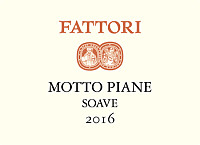
|
|
Soave Motto Piane 2016 |
|
| Fattori (Veneto, Italy) | |
 Garganega Garganega | |
| Price: € 11.80 | Score: |
 Brilliant golden yellow and nuances of golden yellow, very
transparent. Brilliant golden yellow and nuances of golden yellow, very
transparent.
 Intense, clean, pleasing, refined and elegant, starts with hints of
quince, medlar and peach followed by aromas of pear, citrus fruits,
pineapple, hawthorn, broom, plum, honey and sage. Intense, clean, pleasing, refined and elegant, starts with hints of
quince, medlar and peach followed by aromas of pear, citrus fruits,
pineapple, hawthorn, broom, plum, honey and sage.
 Crisp attack and however balanced by alcohol, good body, intense
flavors, pleasing roundness. Crisp attack and however balanced by alcohol, good body, intense
flavors, pleasing roundness.
 Persistent finish with flavors of quince, medlar and peach. Persistent finish with flavors of quince, medlar and peach. Made from Garganega grapes dried for 30 days, aged in steel tanks
and cask. Made from Garganega grapes dried for 30 days, aged in steel tanks
and cask.
|
|
 Pasta and risotto with vegetables and crustaceans, Mushrooms soups, Sauteed white meat, Roasted fish Pasta and risotto with vegetables and crustaceans, Mushrooms soups, Sauteed white meat, Roasted fish |
|
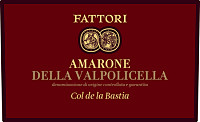
|
|
Amarone della Valpolicella Col de la Bastia 2014 |
|
| Fattori (Veneto, Italy) | |
 Corvina (65%), Corvinone (15%), Rondinella (10%), Other Grapes (10%) Corvina (65%), Corvinone (15%), Rondinella (10%), Other Grapes (10%) | |
| Price: € 31.50 | Score: |
 Intense ruby red and nuances of garnet red, little transparency. Intense ruby red and nuances of garnet red, little transparency. Intense, clean, pleasing and refined, starts with hints of blackberry,
plum and black cherry followed by aromas of dried violet, blueberry,
chocolate, tobacco, cinnamon, vanilla and menthol. Intense, clean, pleasing and refined, starts with hints of blackberry,
plum and black cherry followed by aromas of dried violet, blueberry,
chocolate, tobacco, cinnamon, vanilla and menthol.
 Tannic attack and however balanced by alcohol, full body, intense
flavors, pleasing roundness. Tannic attack and however balanced by alcohol, full body, intense
flavors, pleasing roundness.
 Persistent finish with flavors of blackberry, plum and black cherry. Persistent finish with flavors of blackberry, plum and black cherry. 24 months in cask. 24 months in cask. |
|
 Game, Roasted meat, Stewed and braised meat, Hard cheese Game, Roasted meat, Stewed and braised meat, Hard cheese |
|
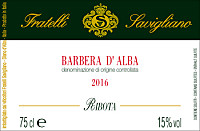
|
|
Barbera d'Alba Ribota 2016 |
|
| Fratelli Savigliano (Piedmont, Italy) | |
 Barbera Barbera | |
| Price: € 9.00 | Score: |
 Intense ruby red and nuances of ruby red, little transparency. Intense ruby red and nuances of ruby red, little transparency. Intense, clean, pleasing and refined, starts with hints of cherry, plum
and blueberry followed by aromas of violet, blackberry, chocolate, tobacco,
mace, vanilla and menthol. Intense, clean, pleasing and refined, starts with hints of cherry, plum
and blueberry followed by aromas of violet, blackberry, chocolate, tobacco,
mace, vanilla and menthol.
 Properly tannic attack and however balanced by alcohol, good body,
intense flavors, pleasing crispness. Properly tannic attack and however balanced by alcohol, good body,
intense flavors, pleasing crispness.
 Persistent finish with flavors of cherry, plum and blackberry. Persistent finish with flavors of cherry, plum and blackberry. 12 months in barrique, at least 12 months in bottle. 12 months in barrique, at least 12 months in bottle. |
|
 Stuffed pasta, Broiled meat and barbecue, Stewed meat with mushrooms, Roasted meat Stuffed pasta, Broiled meat and barbecue, Stewed meat with mushrooms, Roasted meat |
|
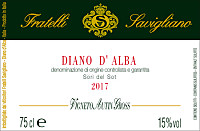
|
|
Diano d'Alba Sori del Sot Vigneto Autin Gross 2017 |
|
| Fratelli Savigliano (Piedmont, Italy) | |
 Dolcetto Dolcetto | |
| Price: € 7.50 | Score: |
 Deep ruby red and nuances of purple red, little transparency. Deep ruby red and nuances of purple red, little transparency. Intense, clean, pleasing and refined, starts with hints of cherry, plum
and violet followed by aromas of blackberry, raspberry, strawberry, almond,
blueberry, pink pepper and menthol. Intense, clean, pleasing and refined, starts with hints of cherry, plum
and violet followed by aromas of blackberry, raspberry, strawberry, almond,
blueberry, pink pepper and menthol.
 Properly tannic attack and however balanced by alcohol, good body,
intense flavors, pleasing roundness. Properly tannic attack and however balanced by alcohol, good body,
intense flavors, pleasing roundness.
 Persistent finish with flavors of cherry, plum and blackberry. Persistent finish with flavors of cherry, plum and blackberry. 3 months in cask, 8 months in bottle. 3 months in cask, 8 months in bottle. |
|
 Stuffed pasta with mushrooms, Sauteed meat, Broiled meat and barbecue, Stewed meat Stuffed pasta with mushrooms, Sauteed meat, Broiled meat and barbecue, Stewed meat |
|
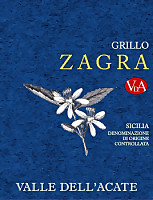
|
|
Zagra 2017 |
|
| Valle dell'Acate (Sicily, Italy) | |
 Grillo Grillo | |
| Price: € 11.00 | Score: |
 Pale golden yellow and nuances of straw yellow, very transparent. Pale golden yellow and nuances of straw yellow, very transparent. Intense, clean, pleasing and refined, starts with hints of apple,
citrus fruits and peach followed by aromas of pear, hawthorn, plum, broom,
pineapple, almond and mineral. Intense, clean, pleasing and refined, starts with hints of apple,
citrus fruits and peach followed by aromas of pear, hawthorn, plum, broom,
pineapple, almond and mineral.
 Crisp attack and however balanced by alcohol, good body, intense
flavors, pleasing roundness. Crisp attack and however balanced by alcohol, good body, intense
flavors, pleasing roundness.
 Persistent finish with flavors of apple, plum and almond. Persistent finish with flavors of apple, plum and almond. 4 months in steel tanks, 4 months in bottle. 4 months in steel tanks, 4 months in bottle. |
|
 Pasta with fish, Fried fish, Stuffed pasta with vegetables, Vegetable soups Pasta with fish, Fried fish, Stuffed pasta with vegetables, Vegetable soups |
|
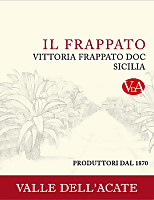
|
|
Vittoria Frappato 2017 |
|
| Valle dell'Acate (Sicily, Italy) | |
 Frappato Frappato | |
| Price: € 13.00 | Score: |
 Brilliant ruby red and nuances of ruby red, moderate transparency. Brilliant ruby red and nuances of ruby red, moderate transparency. Intense, clean, pleasing and refined, starts with hints of cherry,
strawberry and raspberry followed by aromas of rose, blueberry, plum,
violet, blackberry and black pepper. Intense, clean, pleasing and refined, starts with hints of cherry,
strawberry and raspberry followed by aromas of rose, blueberry, plum,
violet, blackberry and black pepper.
 Properly tannic attack and however balanced by alcohol, good body,
intense flavors, pleasing crispness. Properly tannic attack and however balanced by alcohol, good body,
intense flavors, pleasing crispness.
 Persistent finish with flavors of cherry, strawberry and raspberry. Persistent finish with flavors of cherry, strawberry and raspberry. 6 months in steel tanks, at least 3 months in bottle. 6 months in steel tanks, at least 3 months in bottle. |
|
 Cold cuts, Pasta with meat and mushrooms, Sauteed meat, Fish soups Cold cuts, Pasta with meat and mushrooms, Sauteed meat, Fish soups |
|
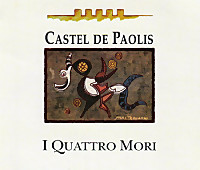
|
|
I Quattro Mori 2013 |
|
| Castel De Paolis (Latium, Italy) | |
 Syrah (40%), Cabernet Sauvignon (30%), Merlot (20%), Petit Verdot (10%) Syrah (40%), Cabernet Sauvignon (30%), Merlot (20%), Petit Verdot (10%) | |
| Price: € 27.00 | Score: |
 Intense ruby red and nuances of garnet red, little transparency. Intense ruby red and nuances of garnet red, little transparency. Intense, clean, pleasing, refined and elegant, starts with hints of
black currant, plum and dried violet followed by aromas of black cherry,
blueberry, peony, chocolate, tobacco, cinnamon, leather, mace, vanilla and
eucalyptus. Intense, clean, pleasing, refined and elegant, starts with hints of
black currant, plum and dried violet followed by aromas of black cherry,
blueberry, peony, chocolate, tobacco, cinnamon, leather, mace, vanilla and
eucalyptus.
 Properly tannic attack and however balanced by alcohol, good body,
intense flavors, pleasing roundness. Properly tannic attack and however balanced by alcohol, good body,
intense flavors, pleasing roundness.
 Persistent finish with flavors of black currant, plum and black cherry. Persistent finish with flavors of black currant, plum and black cherry. Aged in barrique. Aged in barrique. |
|
 Roasted meat, Broiled meat and barbecue, Braised and stewed meat with mushrooms, Hard cheese Roasted meat, Broiled meat and barbecue, Braised and stewed meat with mushrooms, Hard cheese |
|
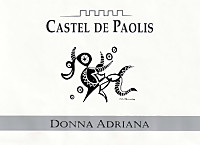
|
|
Donna Adriana 2016 |
|
| Castel De Paolis (Latium, Italy) | |
 Viognier (80%), Malvasia del Lazio (20%) Viognier (80%), Malvasia del Lazio (20%) | |
| Price: € 16.00 | Score: |
 Brilliant straw yellow and nuances of straw yellow, very transparent. Brilliant straw yellow and nuances of straw yellow, very transparent. Intense, clean, pleasing, refined and elegant, starts with hints of
apple, pineapple and citron followed by aromas of pear, papaya, acacia,
lychee, medlar, acacia honey, plum, broom, hawthorn and mineral. Intense, clean, pleasing, refined and elegant, starts with hints of
apple, pineapple and citron followed by aromas of pear, papaya, acacia,
lychee, medlar, acacia honey, plum, broom, hawthorn and mineral.
 Crisp attack and however balanced by alcohol, good body, intense
flavors, agreeable. Crisp attack and however balanced by alcohol, good body, intense
flavors, agreeable.
 Very persistent finish with long flavors of apple, pineapple and
papaya. Very persistent finish with long flavors of apple, pineapple and
papaya.
 Aged in steel tanks. Aged in steel tanks. |
|
 Stuffed pasta with fish and mushrooms, Roasted fish, Roasted white meat, Stewed fish, Dairy products Stuffed pasta with fish and mushrooms, Roasted fish, Roasted white meat, Stewed fish, Dairy products |
|
|
||||||||
|
DiWineTaste Polls
|
| |||||||
Privacy Policy | |||||||


| Copyright © 2002-2024 Antonello Biancalana, DiWineTaste - All rights reserved |
| All rights reserved under international copyright conventions. No part of this publication and of this WEB site may be
reproduced or utilized in any form or by any means, electronic or mechanical, without permission in writing from DiWineTaste. |